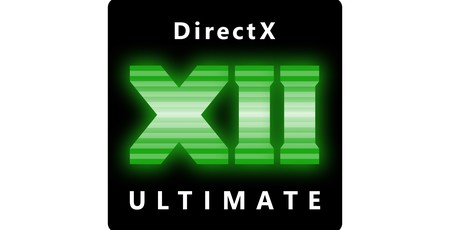
With its next-gen console hardware specifications now a known entity, Microsoft has announced DirectX 12 Ultimate, an update to its API that includes four key rendering features, all of which the Xbox Series X will fully support.
DirectX feature updates are Microsoft’s way of bundling the latest advances in GPU technology into a single package, primarily to make the lives of game developers easy and create a baseline for future games to work from.
Traditionally, DirectX 12 Ultimate would have been called DirectX feature level 12_2, but as a key player in both PC and console gaming, Microsoft has been working to unify the Windows 10 and Xbox ecosystems over the years, and DX12 Ultimate is its next step. The logo, seen above, will be slapped onto the packaging and marketing materials for PC graphics hardware to indicate feature parity with the Xbox Series X, which is confirmed as having full hardware-level support for all the new features. ‘This mark of quality ensures stellar “future-proof” feature support for next generation games!’ writes Microsoft.
Those four new features are as follows:
- DirectX Raytracing 1.1: An update to the most well-known feature of DX12 that adds new capabilities including inline ray tracing, giving developers more control over the ray tracing process.
- Variable Rate Shading: The ability to vary the rate of shading in a scene to improve or degrade visual quality depending on the level of detail required.
- Mesh Shaders: Harnessing GPU compute power to make the geometry pipeline more efficient and flexible, dramatically raising the number of objects that can be in a scene without crippling the CPU.
- Sampler Feedback: Querying texture samplers to more intelligently pick which part of a texture to load into memory and thus more efficiently use available VRAM.
DirectX already supports DXR (version 1.0) and VRS, but DirectX 12 Ultimate will enhance both of these while adding Mesh Shaders and Sampler Feedback for the first time. Microsoft has a lot more detail on all four features in its announcement blog.
Nvidia: Ready now with RTX
If any of the above sounds familiar, it’s because they were all introduced at the hardware level to the PC ecosystem in 2018 by – you guessed it – Nvidia’s RTX cards and its Turing architecture (Sampler Feedback is enabled by Texture Space Shading). Nvidia wastes no time highlighting this in its own blog on DX12 Ultimate. The main message is that more developers will now be able to leverage the techniques that Nvidia's hardware laid the foundations for.
‘With the inclusion of ray tracing in DirectX 12 Ultimate, all major game engines, and next-gen consoles, the adoption of ray tracing is set to take off in the coming year. And it’ll look and run best on GeForce RTX GPUs due to dedicated ray tracing hardware called RT Cores, and our performance-boosting DLSS technology,’ the green team suggests.
Nvidia has also confirmed that the above features ‘are fully – and currently only – supported by GeForce RTX graphics cards and laptops’. If we had to guess, we’d say that the Turing GTX GPUs like the GTX 1660 Ti also fully support DirectX 12 Ultimate, because they’re known to technically support DXR, but either way it's clear where the focus lies. Nvidia also has a new video with handy demonstrations of the new features:
AMD: Full support coming, but not yet (and PS5?)
For AMD, full support will only come with the RDNA 2 architecture that drives not only the Xbox Series X, but also its upcoming Navi 2 graphics cards and the Sony PlayStation 5. As a quick aside, the degree to which the PS5 will support the above features is mostly unknown. We already know ray tracing is supported, of course, and lead architect Marc Cerny has discussed 'primitive shaders' that sound very similar to Mesh Shaders, but VRS and Sampler Feedback are complete unknowns. The RDNA 2 architecture should make it possible for Sony to achieve similar techniques (it won't be using DirectX 12, of course), but it is a custom implementation, so there are no guarantees - Sony has been silent on the matter thus far.
AMD’s own DX12 Ultimate blog highlights that the company had a role in the development of DXR 1.1 to achieve better efficiency and performance in many ray tracing effects, and it includes a video of a demo called Futuristic City, which shows DXR running on AMD RDNA 2 silicon for the first time:
Sadly, there is still no concrete information about when PC gamers can expect Navi 2 graphics cards. The Microsoft blog does point out that ‘when Xbox Series X releases [currently Holiday 2020], there will already be many millions of DX12 Ultimate PC graphics cards in the world with the same feature set’, but whether that refers to Nvidia RTX and AMD Navi 2 or just RTX is deliberately unclear.
While the new DX12 Ultimate features have been available on the Windows Insider Program since October, their public release will come in the Windows 10 20H1 build, which as the name suggests should be out in the first half of the year.

MSI MPG Velox 100R Chassis Review
October 14 2021 | 15:04








Want to comment? Please log in.